Soldiers on skates
Author Frits Locher, 2017
Translation Cheryl Richardson, 2020
Count Willem II (1234-1256)

The oldest and most famous fight on ice is probably that of late January 1256.
Count William II, who had been a Count in Holland for 14 years and crowned King of the Great German Empire by Pope Innocent at the age of twenty, brought the county of Holland into being. He gave city rights to Haarlem (1245), Delft (1246), s-Gravenzande (1246) and Alkmaar (1254) and commissioned the construction of the Binnenhof in The Hague.
William II waged several wars against the West Frisians. During a campaign on January 28, 1256, with armor and seated on his horse, he crashed through the ice at Hoogwoud of the Berkmeer. The West Frisians found him in this powerless position and killed him. They thought they had killed a simple nobleman.
The Eighty Years' War (1568 - 1648)
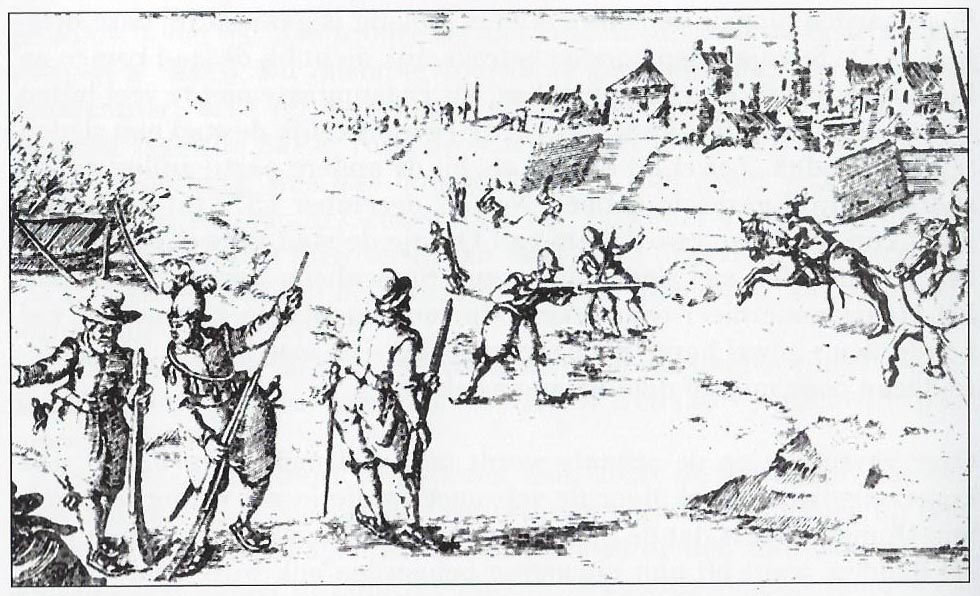
During the Eighty Years War there were acts of war in which winter ice and skates played a role. A few things are known about the siege of Haarlem during the harsh winter December 1572 - February 1573.
People have often wondered whether this harsh winter was beneficial for the Spaniards or for the people of Haarlem under siege. The Spaniards could get relatively close to Haarlem and cross the moat for an attack if there were not too many holes chopped in the ice. On the other hand, it was quite easy to supply the city with sledges. On some days, hundreds – both on foot and horseback - entered the city.
Not much has been said about fighting on skates. At the end of January 1573 the Spaniards carried out a major attack on the city. They conquered different city gates but were beaten back.
Messengers on skates were sent to reach Prince William of Orange between the Spanish lines. This nocturnal courier service is the oldest evidence of a war action skates.
The Spaniard Berdardino de Mendoca - who kept a diary about his experiences as a soldier in Holland - describes Dutch activity on ice.
"They had some kind of spurs, like the custom of the land, that entails two sharp staples on a board of iron, studded, that closes in the hollow and on the sole of the foot to allow standing on the ice without slipping and to keep so and walk and fight; why the Duke (Alva) had ordered seven thousand of them thus ".
The disaster year 1672
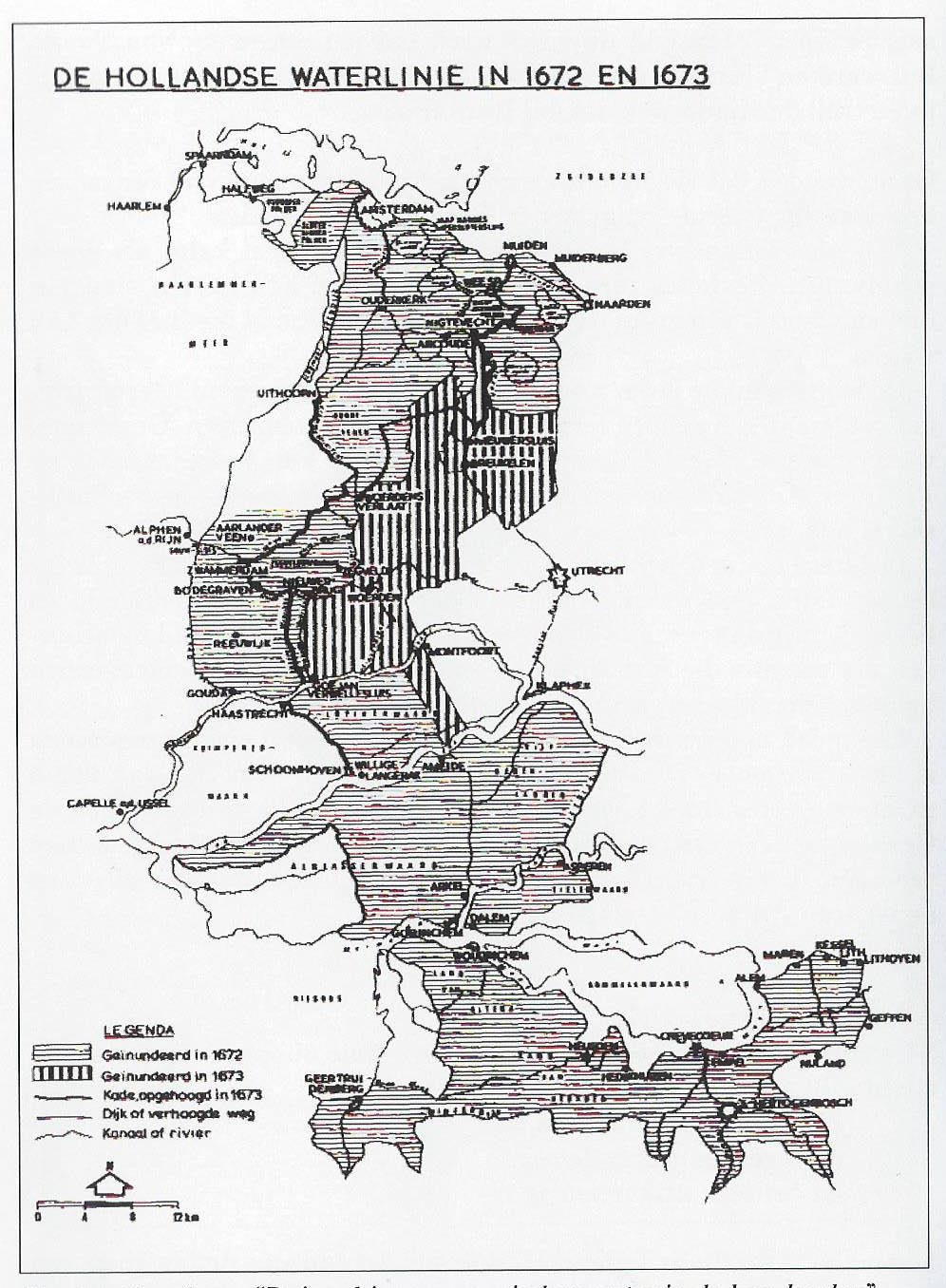
Louis IV of France invaded the Netherlands with the help of the Bishop of Munster and Cologne.
On the east side, the Dutch Waterline kept the enemy out. But people, afraid that the winter would be severe and as a precaution, made thousands of skates and mud tracks.
The enemy had 10,000 to 20,000 men ready to push through the frozen Waterline to The Hague when it froze and in mid-December 1672, a severe frost did fall. Approximately 7,800 people on foot, 900 horsemen and 300 dragoons set out over the ice.
The water management engineers keep the water in constant motion with the use of windmills to thin the ice. Large holes were chopped everywhere by volunteers and soldiers. To this end, 2,100 men were given 1582 axes and 543 ice hooks. Nevertheless, the French army arrived near Woerden on the 28th of December. But the bridge at Zwammerdam had been raised and it became impossible to move on. In any case, the ice was too thin. On December 29th a thaw set in and the French had to accept a retreat.
Frost fell again at the end of January 1673. 500 French with 300 sledges were on their way to plunder Linschoten, Oudewater and Papekop. Four hundred volunteers from The Hague and Dordrecht chased the French away with muskets at the ready and skates on their feet.
The French invasion of 1795
At the end of the eighteenth century, Europe was literally and figuratively on fire. The French Revolution of 1789 spread like an oil slick all over Europe. During the harsh winter of 1794/1795 the Dutch waters froze. A French army led by Pichegru invaded the country. A call from the government in The Hague to cut holes in the ice and resist did nothing. Most Dutch people saw the Sans Culotten (the French) as liberators. The French crossed frozen rivers such as the Waal and Lek, entered Holland and arrived in Amsterdam on January 20, 1795. Prince Willem V had fled to England with his family ten days earlier.
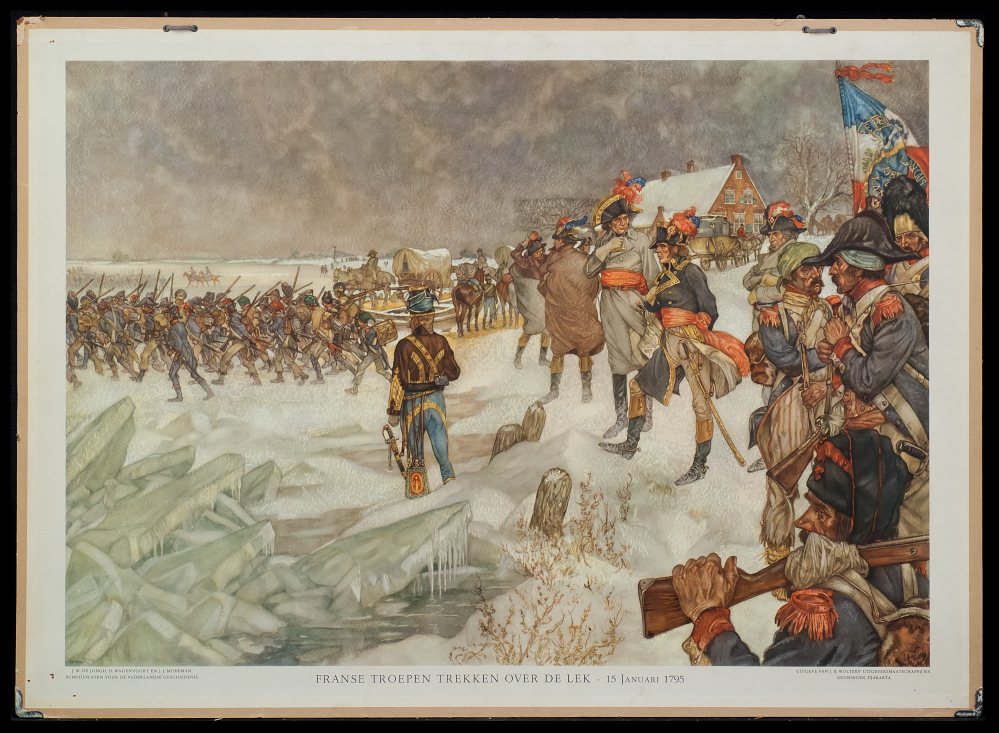
The nineteenth century
The nineteenth century was not a century of major military combat on the ice. There are, however, military exercises on skates. A journalist from the Arnhem newspaper describes such an exercise that took place on January 3, 1848 on the city canals. "..... some of the men and young people under 18 years of age from the depot battalion of the third infantry regiment here in garrison, are led with beating drums, fully armed and packed, ...., provided with skates, different maneuvers on the ice, ..... ".
A number of images of such exercises have also been preserved.
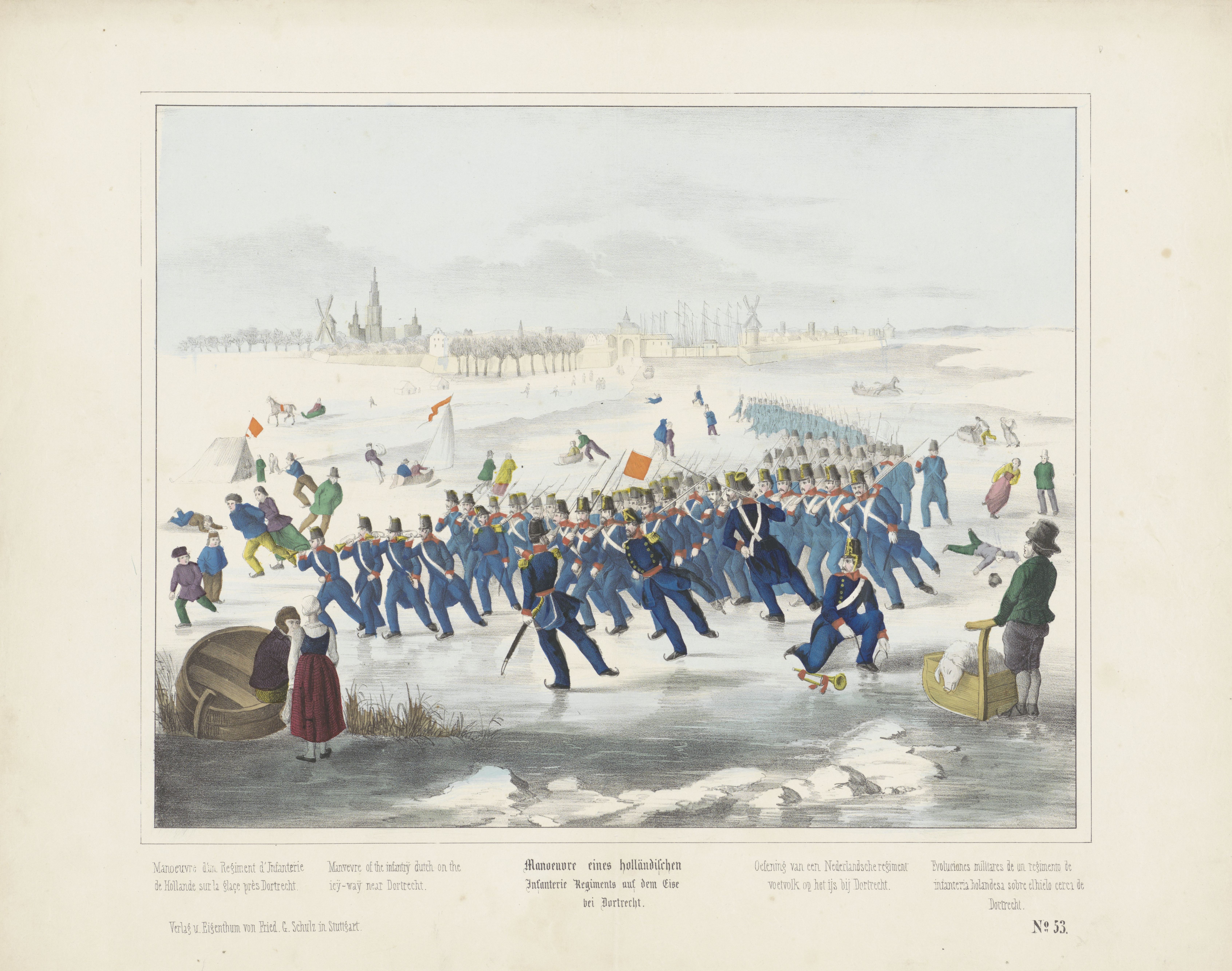
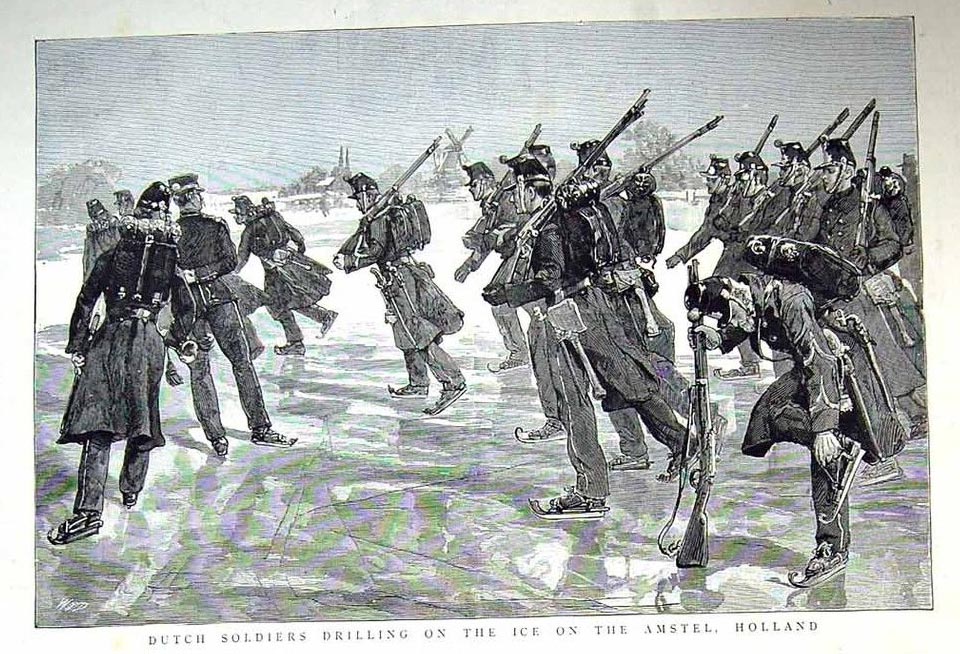
Show of the skating Regiment Grenadiers and Jagers 1895
A special painting in the National Military Museum in Soesterberg is "Show of the skating Regiment Grenadiers and Hunters for Princess Wilhelmina and Queen Mother Emma during the ice festival in The Hague on 14 February 1895". It was a very harsh winter. February was the coldest month in 40 years.
A unit of Grenadiers and Hunters paraded for Queen Mother Emma and her 15-year-old daughter Wilhelmina. The location is the frozen Verversingskanaal in The Hague.
The performance is a journalistic, visual report. There is a strong wind. To brave the cold, the queens wear long fur coats with puffed sleeves. They are standing on a brown fur rug accompanied by ladies-in-waiting and officers. The German flag flying above their heads represents the land ownership of Grand Duchess Sophie of Saxony Weimar and Eisenbach. At the end of the nineteenth century, she had sold the municipality of The Hague the land necessary for the canal to be dug. The painting was painted on canvas by Jan Hoynck van Papendrecht.
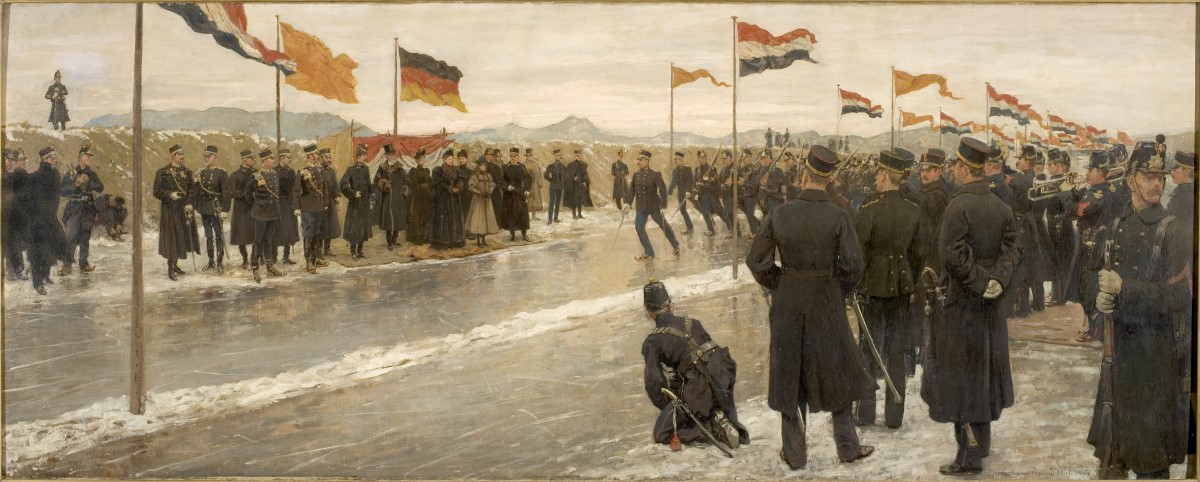
property of the National Military Museum, Soesterberg
The twentieth century
In this century too, there were no combat actions on the ice nor any colourful military exercises as in the nineteenth century. But there were maneuvers on the ice that were almost propagandistic. In addition, the skates used were improved.
For example, practice skates were held during the First World War. The Hague Courant of Friday January 26, 1917 wrote: "The exercises will be simple, because the most important thing is to cover the shortest possible distance. There will be patrols of 200 men, composed of staff and men. The route shall be chosen so that various difficulties must be overcome. " The games were organized for the Garde Grenadiers and Jagers.
Apparently Queen Wilhelmina considered this type of exercise important, because she regularly attended and made silver medals available.
Before the Second World War and the occupation of the Netherlands by the Germans in May 1940, there was a very harsh winter for 10 weeks. The soldiers were called up. During this mobilization in the winter of 1939/40, extensive photo reports of skating soldiers practicing on the frozen water fields were published by weekly magazines such as Het Leven, de Prins and Panorama.

Due to the danger of war, large parts of Gelderland and Utrecht were flooded and guarded by soldiers. Because of the frost, exercises were held on ice and in the snow. Skate patrols were also formed which, due to their rapid movement, were very suitable for surprise attacks. For this purpose, the Minister of Defense bought a large batch (obsolete), probably Waddinxvean skates, from the Nooitgedagt company in IJlst.
At the end of 1944, Nooitgedagt received a large order from the Germans. They demanded 60,000 pairs of skates for the winter of 1944/45. There was no intention to respond to this demand and a cover story was invented. All still usable skates - 50,000 pieces - are packed in 280 boxes and remain with the citizens of IJlst.
Skating competitions on January 26 and 30, 1917
On January 26 and 30, 1917, skating competitions of teams from the army took place.
Friday, January 26, 1917
The teams that competed against each other consisted of 1 officer, 2 non-commissioned officers, 2
corporals and 50 soldiers.
The skating trip was about 60 km long. After reaching the finish the competitors had to run another 300 meters to the finish.
During the journey there were several difficulties to overcome, including repelling an attack.
The journey led from the start in Gouda over Woerden and Bodegraven to De Meern (near Utrecht); a canteen had been set up there, where one rested for an hour and got pea soup before going back . Then they went on skates to Gouda.
The prize consisted of a silver and a bronze medal, presented by Her Majesty Queen Wilhelmina, and two guilders per head for the first team and one guilder per head for the second team.
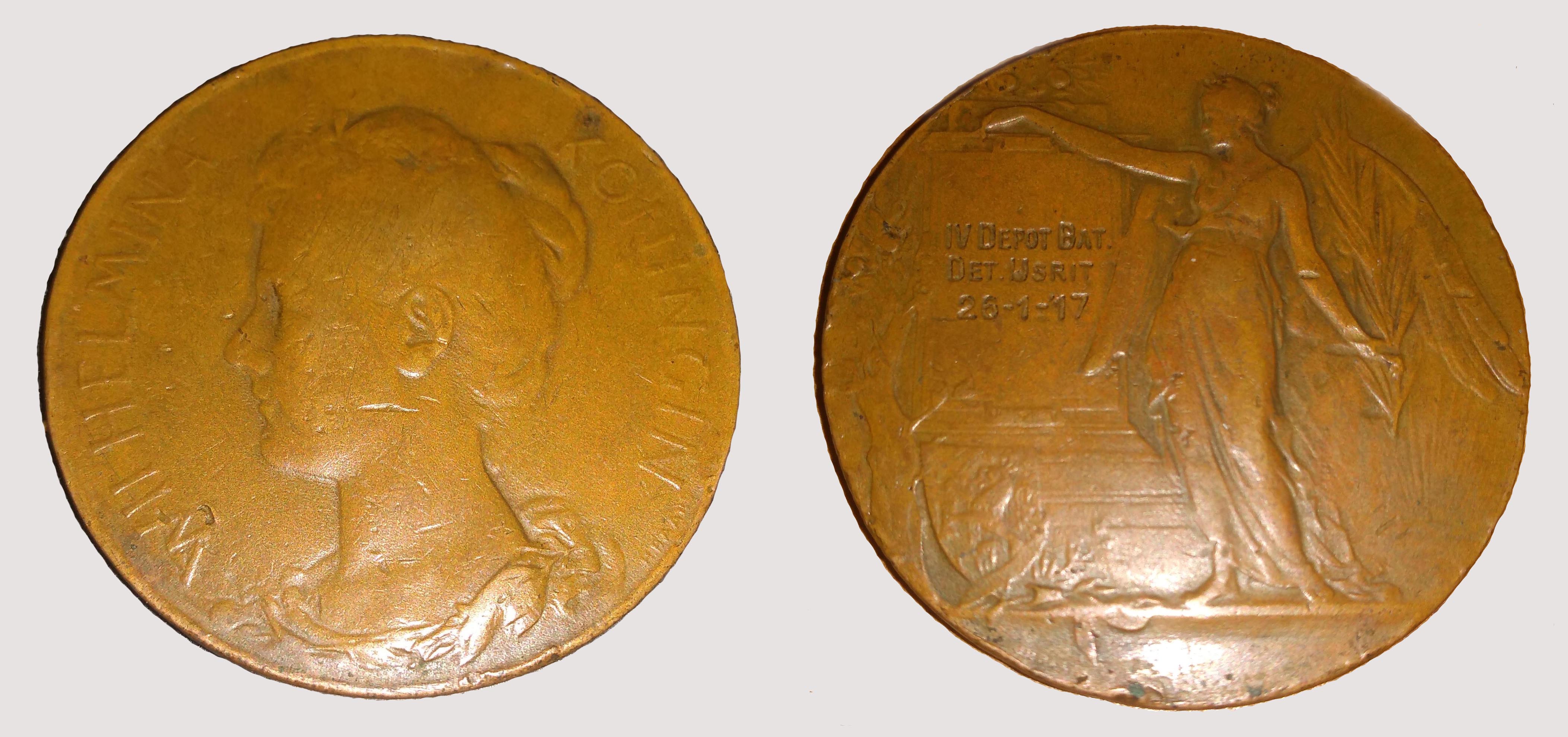
The winning team finished in a time of 3 hours and 47 minutes. Nobody did drop out.
The second prize winning team took 13 minutes longer and had 2 dropouts.
The time, the number of drop-outs and the impression the jury got of the team, were important in determining the final score.
Tuesday, January 30, 1917
On this day another skating competition was held and the winners received another medal that did not come from Queen Wilhelmina.
Read more
More articles about the history of skating
Sources
Two sources in particular were used.
1. "The army on skates, The role of the ice in military operations in a historical perspective", a private publication of Anrie Broere
2. Article "Ten IJse 8 - Patins de Hollande", listed in Kouwe Drukte, volume 15 number 42, page 36, October 2011; publication of the De Poolster Foundation